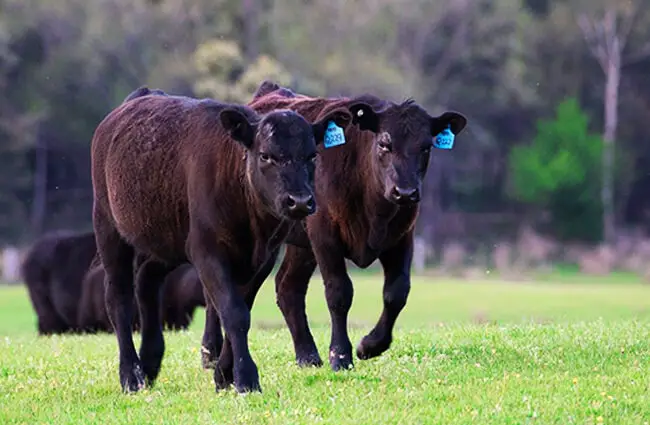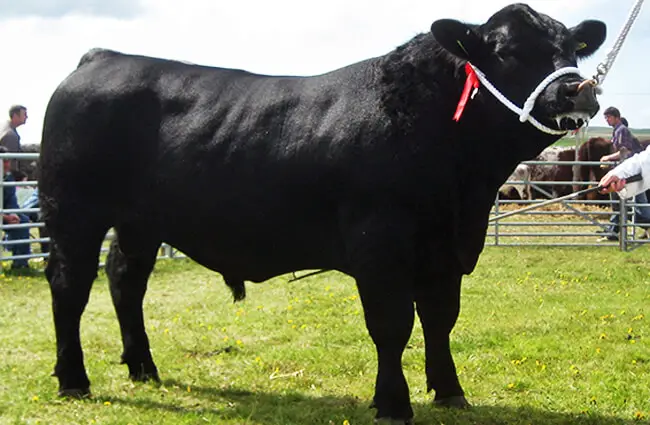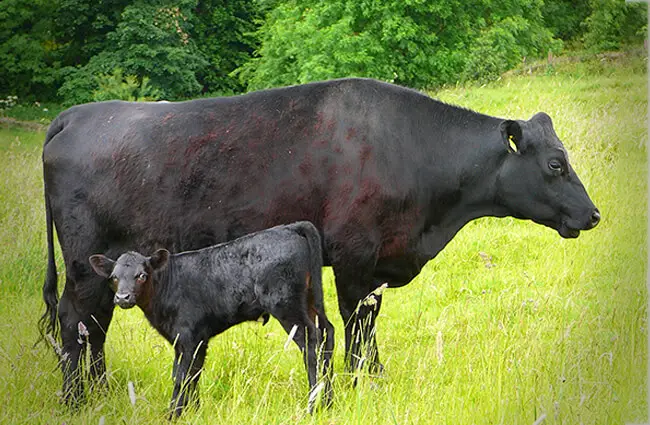The Enduring Legacy of Black Angus: A Story of Resilience and Quality
In the vast tapestry of the animal kingdom, some species stand out not just for their wild beauty, but for their profound connection with humanity. Among these, the Black Angus cattle hold a particularly esteemed position. Far from being just another farm animal, these magnificent bovines embody a fascinating blend of natural hardiness, selective breeding, and an unparalleled contribution to global agriculture and culinary traditions. As a zoologist who has spent years unraveling the mysteries of the natural world, it is a delight to delve into the story of the Black Angus, an animal that has truly shaped landscapes and livelihoods across continents.
A Portrait of the Black Angus: Key Characteristics
The Black Angus is instantly recognizable, even to the untrained eye. Its most defining feature is its striking, solid black coat, which gives the breed its name. While variations like Red Angus exist as a separate breed, the classic Black Angus is a picture of sleek, dark elegance. Beyond color, these cattle are naturally polled, meaning they are born without horns, a trait that has been highly valued in their domestication for safety and ease of handling.
They are medium to large in size, possessing a muscular, well-proportioned body that speaks to their robust nature. Adult bulls can weigh upwards of 1,800 to 2,200 pounds, while cows typically range from 1,200 to 1,500 pounds. Despite their impressive stature, Black Angus are generally known for their docile temperament, making them relatively easy to manage for farmers and ranchers. This combination of physical prowess and calm demeanor has contributed significantly to their widespread popularity.
![Black Angus cows are grazing on organic pastures Photo by: U.S. Department of Agriculture [public domain] https://creativecommons.org/licenses/by/2.0/](https://animals.net/wp-content/uploads/2020/03/Black-Angus-2-650x425.jpg)
From Scottish Hills to Global Ranches: The Black Angus Journey
The tale of the Black Angus begins in the rugged, windswept northeastern counties of Scotland, specifically Aberdeenshire and Angus, during the 18th century. Here, native polled cattle, known for their hardiness and ability to thrive in challenging conditions, were selectively bred and refined. Early breeders like Hugh Watson and William McCombie played pivotal roles in establishing the breed’s distinctive characteristics, focusing on traits that would produce superior beef.
The breed’s evolution was driven by a desire for efficient meat production. Farmers recognized the value of cattle that could convert forage into high-quality muscle efficiently. The polled trait, initially a natural variation, became a cornerstone of the breed, eliminating the need for dehorning and reducing injury risks within herds. By the mid-19th century, the Angus breed began its journey across the Atlantic, arriving in North America. Its adaptability to diverse climates, excellent mothering abilities, and superior meat quality quickly made it a favorite among ranchers, leading to its global proliferation. Today, Black Angus cattle are found in virtually every corner of the world where beef is produced, a testament to their enduring genetic strengths.

Grazing Giants: Diet and Digestive Wonders
As true herbivores, Black Angus cattle are masters of converting plant matter into energy and muscle. Their diet primarily consists of grasses and forages found in pastures. On ranches, this is supplemented with hay, especially during winter months or periods of drought when fresh pasture is scarce. Silage, a fermented feed made from chopped green fodder, also forms a significant part of their diet in many operations.
Like all cattle, Black Angus possess a remarkable digestive system, characterized by a four-compartment stomach. This ruminant system allows them to efficiently break down cellulose, a complex carbohydrate found in plant cell walls, which most other mammals cannot digest. The process involves chewing, regurgitating, and re-chewing their cud, a fascinating display of biological efficiency. While primarily grass-fed, many Black Angus are finished on a diet of grains, such as corn or barley, to promote rapid weight gain and enhance the marbling of their meat, a key factor in its renowned tenderness and flavor.
![Curious Black Angus steer Photo by: U.S. Department of Agriculture [public domain] https://creativecommons.org/licenses/by/2.0/](https://animals.net/wp-content/uploads/2020/03/Black-Angus-4-650x425.jpg)
The Cycle of Life: Mating and Reproduction
The reproductive cycle of Black Angus cattle is a cornerstone of their economic importance. Cows typically reach sexual maturity around 12 to 15 months of age, though breeding usually commences when they are about 15 to 24 months old, ensuring they are physically mature enough to carry a calf to term. The gestation period for a Black Angus cow is approximately 283 days, or just over nine months, similar to other bovine breeds.
Calving usually occurs in the spring, a natural timing that allows calves to be born when weather conditions are milder and fresh forage is abundant. Black Angus cows are celebrated for their strong maternal instincts, providing excellent care and protection for their offspring. Calves are born relatively small, typically weighing between 60 to 80 pounds, which contributes to easier calving and reduced complications for the mother. They grow rapidly, suckling from their mothers for several months before being weaned. This efficient reproductive cycle, combined with the cows’ good mothering abilities, makes Black Angus a highly productive breed for ranchers.

Black Angus and the Ecosystem: More Than Just Livestock
While primarily domesticated animals, Black Angus cattle, particularly those in extensive grazing systems, interact with their environment in significant ways. Their grazing habits can have a profound impact on pasture ecosystems. When managed sustainably, grazing can be beneficial, promoting plant diversity, stimulating new growth, and helping to control invasive species. Their hooves can also break up soil, aiding in aeration and seed dispersal. However, overgrazing can lead to soil erosion, degradation of pasture quality, and reduced biodiversity, highlighting the importance of responsible land management.
In terms of interaction with other animals, Black Angus cattle in open pastures may encounter various wildlife. They are generally large enough to deter smaller predators, but calves can be vulnerable to coyotes, wolves, or bears in regions where these predators exist. Ranchers often employ various strategies, including guard dogs or careful herd management, to protect their cattle. In a broader sense, their presence on ranches creates a specific type of managed ecosystem, influencing everything from insect populations to bird species that feed on insects or seeds disturbed by grazing.
![A herd of Black Angus Photo by: U.S. Department of Agriculture [public domain] https://creativecommons.org/licenses/by/20/](https://animals.net/wp-content/uploads/2020/03/Black-Angus-5-650x425.jpg)
Black Angus in Human Society: A Cultural and Economic Cornerstone
The Black Angus breed’s contribution to human culture and economy is immense. They are arguably the most popular beef breed globally, renowned for producing high-quality, well-marbled meat. This marbling, the intramuscular fat, is what gives Angus beef its characteristic tenderness, juiciness, and rich flavor, making it a favorite among chefs and consumers alike. The “Certified Angus Beef” program, established in 1978, further solidified the breed’s reputation for premium quality, setting stringent standards for marbling, maturity, and muscling.
Economically, the Black Angus industry is a multi-billion-dollar enterprise, supporting countless ranchers, feedlot operators, processors, and retailers worldwide. Their efficiency in converting feed to muscle, combined with their adaptability and reproductive success, makes them an incredibly valuable asset in the livestock sector. Beyond the plate, Black Angus cattle represent a significant part of agricultural heritage, symbolizing the dedication and hard work of generations of farmers and ranchers. They are a living testament to the power of selective breeding and human ingenuity in shaping animal populations for specific purposes.

Encountering Black Angus: A Guide for Animal Lovers and Hikers
For the animal lover hoping to spot a Black Angus in its “natural habitat,” it is important to understand that these are domesticated animals. They are not found roaming truly wild in forests or mountains like deer or bears. Instead, you will find Black Angus on farms, ranches, and pastures across agricultural regions. Look for them in open fields, often grazing in herds, particularly in areas known for cattle farming.
If you are a hiker traversing trails that pass through or near pastures where Black Angus are present, safety and respect are paramount. While generally docile, these are large, powerful animals. Here are some guidelines:
- Maintain Distance: Always keep a respectful distance from cattle. Do not attempt to approach, pet, or feed them.
- Do Not Provoke: Avoid sudden movements, loud noises, or anything that might startle or agitate the animals.
- Be Aware of Calves: Cows with calves can be particularly protective. Give them extra space and avoid getting between a cow and her calf.
- Keep Dogs Leashed: If you are hiking with a dog, keep it on a leash and under control. Dogs can be perceived as a threat by cattle.
- Observe Body Language: If a cow seems agitated (head down, pawing the ground, snorting), slowly and calmly back away.
- Respect Fences and Gates: If you are on public land crossing private property, stick to marked paths and close any gates you open.
Enjoy observing these magnificent animals from afar, appreciating their role in the landscape and their calm presence.
Caring for Black Angus: Insights for Zookeepers and Aspiring Zoologists
For an aspiring zoologist or a zookeeper tasked with caring for Black Angus, understanding their specific needs is crucial for their well-being and productivity. While they are domesticated, their care requires a deep understanding of bovine biology and behavior.
Daily Care and Husbandry
- Dietary Needs: A balanced diet is essential. This includes high-quality forage (grass, hay, silage) and appropriate supplements. For growing animals or lactating cows, grain supplementation may be necessary. Access to fresh, clean water at all times is non-negotiable. Mineral blocks or supplements should be provided to ensure adequate intake of essential nutrients.
- Shelter: While hardy, Black Angus benefit from protection from extreme weather. Open-sided shelters or natural windbreaks (trees, hills) are often sufficient in temperate climates. During harsh winters or intense summer heat, more substantial shelter or shade structures are vital.
- Health Monitoring: Regular health checks are critical. This includes observing for signs of illness (lethargy, loss of appetite, unusual discharge), lameness, or injury. A robust vaccination program, parasite control (deworming), and hoof care are standard practices. Working closely with a veterinarian is paramount.
- Social Structure: Black Angus are herd animals and thrive in social groups. Isolation can cause stress. Ensuring they have companions is important for their psychological well-being.
Breeding Programs
For breeding Black Angus, careful genetic selection is key to maintaining and improving breed characteristics. This involves choosing bulls and cows with desirable traits such as good growth rates, feed efficiency, calving ease, and excellent meat quality. Reproductive management includes monitoring estrus cycles, artificial insemination (AI) for genetic improvement, and natural breeding with proven sires.
Environmental Enrichment
Even in a managed environment, enrichment is beneficial. This can include:
- Pasture Rotation: Moving cattle to fresh pastures not only benefits the land but also provides new foraging opportunities and environmental stimulation.
- Social Interaction: Allowing natural herd dynamics to play out, with sufficient space, promotes healthy social behaviors.
- Access to Varied Terrain: If possible, providing pastures with varied topography can encourage natural movement and exercise.
What to Avoid
- Stressors: Loud noises, sudden movements, overcrowding, and rough handling should be avoided as they can cause stress, impacting health and productivity.
- Improper Diet: Sudden changes in diet, feeding moldy or contaminated feed, or an unbalanced nutritional plan can lead to digestive issues and illness.
- Isolation: As social animals, prolonged isolation can lead to behavioral problems and stress.
- Neglecting Health Issues: Prompt attention to any signs of illness or injury is crucial to prevent conditions from worsening.
Caring for Black Angus is a rewarding endeavor that combines scientific knowledge with practical animal husbandry, ensuring these magnificent creatures continue to thrive.
Fascinating Facts About Black Angus
- Naturally Polled: Black Angus are born without horns, a genetic trait that makes them safer to handle and reduces injuries within herds.
- Marbling Masters: They are famous for their excellent marbling, the intramuscular fat that contributes significantly to the tenderness and flavor of their beef.
- Global Dominance: Black Angus is one of the most popular beef breeds worldwide, with a strong presence in North America, South America, Australia, and Europe.
- Hardy and Adaptable: Originating from the harsh climate of Scotland, they are known for their resilience and ability to thrive in diverse environmental conditions.
- Certified Angus Beef: The “Certified Angus Beef” brand is a premium beef program that sets strict quality standards, ensuring consumers receive a superior product.
- Good Mothers: Angus cows are highly regarded for their strong maternal instincts, calving ease, and ability to raise healthy calves.
- Efficient Foragers: Their ruminant digestive system allows them to efficiently convert grass and forage into high-quality protein.
- Color Genetics: While primarily black, the Angus breed also has a red variant, known as Red Angus, which is recognized as a separate breed.
Conclusion: The Enduring Appeal of Black Angus
From the windswept Scottish glens to the vast ranches of the Americas, the Black Angus has carved out an indelible niche in both the natural and human worlds. These remarkable cattle are a testament to the power of selective breeding, embodying a perfect blend of hardiness, adaptability, and unparalleled quality. Whether viewed through the lens of an aspiring zoologist studying their biology, a rancher managing their herds, or a consumer appreciating their culinary contribution, the Black Angus stands as a symbol of agricultural excellence and a fascinating example of humanity’s deep connection with the animal kingdom. Their story is one of enduring legacy, a testament to their quiet strength and profound impact.

![Red Angus Closeup of a beautiful Red Angus cowPhoto by: U.S. Department of Agriculture [pubic domain]https://creativecommons.org/licenses/by/2.0/](https://animals.net/wp-content/uploads/2020/03/Red-Angus-4-238x178.jpg)




![Red Angus Closeup of a beautiful Red Angus cowPhoto by: U.S. Department of Agriculture [pubic domain]https://creativecommons.org/licenses/by/2.0/](https://animals.net/wp-content/uploads/2020/03/Red-Angus-4-100x75.jpg)

